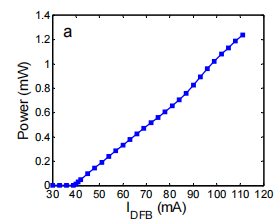A solitary monolithic integrated semiconductor laser (MISL) chip with a size of 780 micrometer is designed and fabricated for broadband chaos generation. Such a MISL chip consists of a DFB section, a phase section and an amplification section. Test results indicate that under suitable operation conditions, this laser chip can be driven into broadband chaos. The generated chaos covers an RF frequency range, limited by our measurement device, of 26.5GHz, and possesses significant dimension and complexity. Moreover, the routes into and out of chaos are also characterized through extracting variety dynamical states of temporal waveforms, phase portraits, RF spectra and statistical indicators.
In this paper, a three-section monolithic integrated semiconductor laser (MISL) chip is specifically designed and fabricated for broadband chaos generation. The overall length of this chip is only 780 micrometer. Without any aid of external perturbations, this solitary MISL chip is able to generate ultra-broadband chaotic signals with RF spectra of beyond 26.5 GHz. Meanwhile, the routes into and out of chaos are confirmed through the observation of diverse nonlinear dynamics. Finally, chaos data analysis is also performed in order to quantify the dimension and complexity of observed various nonlinear dynamics.
Figures 1(a) and 1(b) show the photo and schematic diagram of the MISL, respectively. The epitaxial material of MISL chip is grown on an InP-substrate. Figure 1(b) shows the schematic diagram of the MISL, which consists of a distributed feedback (DFB) section, a phase section and an amplifier section with lengths of 220μm, 240μm and 320μm, respectively. Each section is separated by an electric isolation region. Here, the DFB section and the amplifier section have the same epitaxial structure, which contains seven compressively strained InGaAsP quantum wells and six lattice-matched InGaAsP barriers. Additionally, a gain-coupled Bragg grating has been applied to the DFB section. In the phase section, quantum wells intermixing (QWI) technique is used to make blue-shift of the bandgap to reduce the absorption loss as much as possible. Moreover, the processes of QWI require no additional material re-growth step. Therefore, the use of QWI ensures perfect alignment between different sections of MISL chip and results in a negligibly small interfacial reflection loss. Moreover, a high-reflection coating is applied to the face of amplifier section, and a precise cleavage plane forms the facet of DFB section for optical output. It should be pointed out that low absorption loss in the phase section induced by adopting QWI and high facet reflectivity resulted from coating a high-reflection film are two important factors for chaos generation since enough strong feedback level is needed for realizing chaotic output in such a short external cavity. Finally, three electrodes are welded to the top of MISL, and different injection currents, named as IDFB, IP and IA, can be applied to DFB section, phase section and amplifier section, respectively.
The measurement setup is shown in Fig. 1(c). In this setup, the MISL chip is driven by high-accuracy current sources (ILX-Lightwave, LDC-3724B), and stabled by a thermoelectric controller (ILX-Lightwave, LDT-5412). The temperature of the MISL chip is always stabilized at 25°C during the measurement process. An optical isolators (ISO) (isolation>55dB) is inserted into the optical path to prevent from unwanted external feedback disturbances. The output of MISL is divided into two parts by a beam splitter (BS). One part is injected into an optical spectrum analyzer (OSA, Ando AQ6317C), and the other part is firstly converted to an electrical signal by a fast photo-detector (PD, U2T-XPDV2150R, 47GHz bandwidth), and then analyzed by electronic equipments, such as a radio-frequency (RF) spectrum analyzer (ESA, Agilent E4407B with 26.5GHz bandwidth) and a widebandwidth oscilloscope (OSC, Agilent MSOX92504A with 25GHz bandwidth).
The P-I characteristic and optical spectrum of the MISL are shown in Fig. 2. The P-I curve is obtained when IDFB is altered while IP and IA are fixed as 0mA. Under this circumstance, the threshold current (Ith) of MISL is measured as about 39mA. In Fig. 2(b), the lasing optical spectrum is recorded under different IDFB values. For instance, the lasing wavelength is about 1541.96nm for IDFB = 87mA. It can be observed that the lasing wavelength moves toward longer wavelength along with the increase of IDFB, but always maintains a single mode oscillation. This phenomenon may originate from the fact that only DFB section of MISL is active, and the amplifier section and the phase section work as a passive waveguide since no injection current is applied to them. Therefore, the MISL behaves similar as a normal single mode DFB laser.

Fig
In this paper, a three-section MISL chip is designed and fabricated for broadband chaos generation. The overall size of this chaos laser chip is less than 1 millimeter. Using this solitary laser chip, the chaos exceeding 26.5GHz frequency coverage is successfully produced. Moreover, various nonlinear dynamics are also observed and identified by acquiring temporal waveforms, phase portraits, RF spectra, and statistical indicators D2 and K2. Accordingly, a typical period doubling route into chaos and intermittent transition route out of chaos are defined. This highly integrated chaos generator is helpful for the exploitation of compact, robust and low cost optical chaotic source and has potential applications in ultrafast physical random number generation and on-chip optical chaos communications.